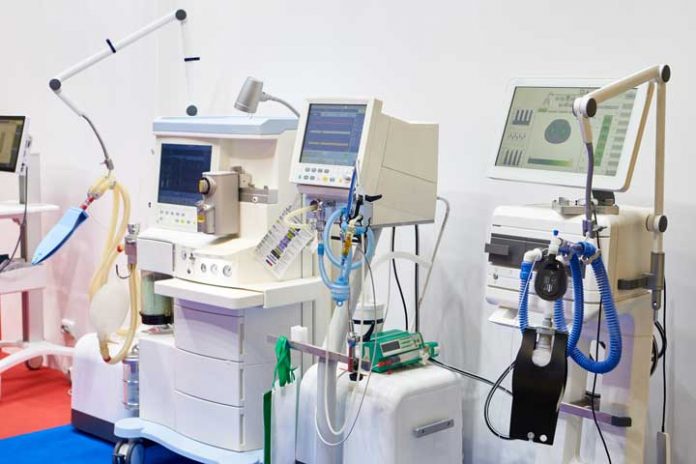by Andrew S. Lewis, NJ Spotlight
This story was written and produced by NJ Spotlight. It is being republished under a special NJ News Commons content-sharing agreement related to COVID-19 coverage. To read more, visit njspotlight.com
Gov. Phil Murphy has called New Jersey’s lack of ventilators “dire,” and has increasingly called on the White House to deliver more from the federal stockpile. Why are there so few ventilators, and why are they key in the fight against COVID-19?
Does New Jersey have enough ventilators?
Murphy has requested 2,500 from the Strategic National Stockpile (SNS), a federal repository of pharmaceuticals and medical equipment that itself is now facing a shortage of masks, gowns, and especially ventilators as cases of COVID-19 soar across the United States.
As of Thursday morning, the state had received 850 from the stockpile. The governor has reiterated that he is still pressing for the outstanding 1,650 from the federal government. “That’s not theoretical,” he said. “We need them.”
Already, some New Jersey hospitals are nearing, or have hit, full ventilator capacity. And without a sufficient, centralized stockpile, states are now locked in a bidding war against each other and the Federal Emergency Management Agency for new Chinese-made ventilators. “It’s like being on eBay with fifty states, bidding on a ventilator,” New York Gov. Andrew Cuomo said in his daily briefing on Tuesday. “And now FEMA is bidding on top of the fifty, so FEMA is driving up the price. What sense does this make?”
In all the uncertainty surrounding effective treatment of COVID-19, there is one thing doctors and health care workers on the front lines are confident of: A mechanical ventilator will prolong the life of many infected patients, and oftentimes is the difference between survival and death.
Why does COVID-19 require mechanical ventilation?
COVID-19 causes the respiratory tree of the lungs to become infected then inflamed, which in the most severe cases causes pneumonia and requires ventilation. Unfortunately, the severe pneumonia caused by COVID-19 is itself different from the more common, bacterial forms of the lung infection.
“In the setting of bacterial pneumonia, you give antibiotics to kill the bacteria,” said Dr. Andrew R. Berman, the Division Director of Pulmonary/Critical Care Medicine at University Hospital in Newark. “The problem with the COVID-19 virus is that there’s nothing really to give [patients].”
The combination of the infection and inflammation results in Acute Respiratory Distress Syndrome, an often fatal complication. “The COVID-19 virus is a problem,” Dr. Berman continued. “But the resultant inflammation is really where these patients end up requiring — and sometimes not necessarily responding to — the mechanical ventilation.”
What is a ventilator and how does it work?
“Ventilators are life support for the lungs,” Dr. Berman, who also serves on the American Lung Association’s New Jersey Leadership Board, said. Simply put, a ventilator is a machine that helps a patient breathe when they are unable to do so on their own.
A patient is sedated and intubated, a highly uncomfortable procedure that involves running a tube into the mouth or nose, and down into the windpipe. The tube is connected to the ventilator, which is then calibrated to deliver, or pump, air into the patient’s lungs that ranges from 21% oxygen content — “room air,” as Dr. Berman called it — all the way up to 100%, depending on the severity of the patient’s condition.
But the machines, which cost about $25,000 each (New York Gov. Andrew Cuomo said on Monday the price has now increased to “over $50,000” because of the bidding war), do much more than pump air into the lungs; in addition to precise percentages of oxygen, they deliver specific flows, volumes and pressures of air, as well as perform constant digital analysis.
Such complexity requires a team of highly skilled operators in the critical-care unit, keeping a round-the-clock watch over a patient whose condition, and oxygen need, is constantly changing. In general, a team of two specialists needs to be on-hand to keep a patient properly ventilated — a respiratory technician, who sets up and troubleshoots the ventilator, and a physician, who oversees the process. The ventilator’s computer then provides digital readouts of each tweak to oxygen, volume and pressure. “It’s a dynamic situation that’s frequently changing,” Dr. Berman said.
How many ventilators will New Jersey need?
In New Jersey there are approximately 2,000 critical-care beds most of which are ventilator-equipped, but the state has projected that it will need to double that number. In order to do that, the state is moving to make room for hundreds more by opening shuttered hospital wings, reopening at least one closed hospital, and building three temporary facilities.
State health officials have said about half the COVID-19 patients now in critical-care beds currently require ventilation, but they fear the need will rise and want every critical-care slot to have this capacity.
Since the federal government has delivered just 850 ventilators, the state is continuing to work on its own to acquire more, in case the outstanding SNS order falls through. “We have not been able to get a non-federal source for acquisition for ventilators successfully,” Murphy said in his Wednesday briefing.
At this point, it’s impossible to know exactly how great New Jersey’s ventilator shortage could become, if at all. Based on the projections for the spread of COVID-19 in New Jersey, Judith Persichilli, the Department of Health Commissioner, said in Wednesday’s briefing by state officials that, with the amount of ventilators the state received from the SNS, “we do believe we’re going to be okay, but we do believe we’re going to be moving ventilators around, from the south to the north, across regions.”
Before the pandemic, the SNS had a total of about 16,600 ventilators — 7,000 have since been distributed nationwide — though a portion of them are not working or require some maintenance and cannot be immediately deployed. This number will fall far short of the need in the coming weeks and months, in which top federal government officials now estimate that the U.S. will see between 100,000 and 240,000 COVID-19 deaths, even under the restrictive social-distancing measures that are being implemented across the country.
Aren’t U.S. companies stepping in to retrofit their factories for production?
On March 21, the U.S. Department of Health and Human Services issued a request for information to identify manufacturers who have current capability to produce ventilators, or who can quickly modify current capabilities to make them. But production will not happen overnight — equipment needs to be retrofitted, and additional engineers and experts employed.
Ford and General Electric have announced plans to manufacture a combined 50,000 ventilators over the next 100 days, and General Motors is also working to produce the machines. Elon Musk, the CEO of Tesla and SpaceX, also said that his factories have the capability to adapt and help. Last week, the U.K.-based company Dyson announced that it had created, in collaboration with The Technology Partnership, a new ventilator machine of which the U.K.’s National Health Service has already ordered 10,000, and Dyson plans on donating 5,000 of the machines “to the international effort” by this month, 1,000 of which will go to the U.K. (A Dyson spokesperson declined to comment on where the remaining 4,000 machines may go, though they said the company has received requests “from all around the globe.”)
Are there viable alternatives for the full-scale ventilators?
There are other options that can be used as alternatives should hospitals experience a shortage of the full-scale ventilators.
“We have what’s called transport ventilators, which are much smaller and more basic,” Dr. Berman said. Transport ventilators are used when a patient needs to be moved from the ICU to another room in the hospital for other short-term procedures, like, for example, a CAT scan. But these ventilators “only control a few of the many things that can be controlled” in the full-scale units. If the national supply does reach full capacity and there are no more full-scale ventilators available, using transport ventilators to treat COVID-19 patients is “definitely an approach” that should be considered, Dr. Berman said.
In Wednesday’s briefing by state officials, Persichilli reported that New Jersey hospitals have been successfully ventilating COVID-19 patients with anesthesia machines, which are essentially simplified ventilators that cannot perform all of the processes of a full-scale ventilator and are usually used only during surgery.
Dr. Berman also said there are non-invasive methods that are being considered, like “high flow” oxygen therapy, which doesn’t require a tube to be inserted into the patient’s lungs. “Every institution uses them,” he said. “It may be a way to take care of someone’s oxygen needs and stave off mechanical ventilation.”
The use of other non-invasive breathing technologies, like CPAP or BiPAP machines —electronic breathing devices most commonly used in the treatment of sleep apnea and chronic obstructive pulmonary disease — has been circulated in recent media reports, but there is some concern among experts that they may not be effective, and even may increase the risk of infectious transmission. “Almost all patients are requiring ventilators for both oxygenation and ventilation,” Dr. Berman said. “And CPAP and BiPAP cannot do these effectively in this population.”
Could hospitals resort to ‘co-venting’?
Murphy and Cuomo have also mentioned “co-venting,” or connecting two patients to the same ventilator, to stretch resources. Dr. Berman acknowledged this is “being discussed by others” — mostly by doctors in New York City — but said that he wasn’t aware of the status of its application in COVID-19 patients. In Thursday’s briefing with state officials, Persichilli confirmed that, currently, no patients in New Jersey are being co-ventilated.
The practice, however, is rare and risky, given the severely weakened state of patients’ lungs and the unique nature of each case; one provider said it is “nearly impossible” to find two patients who are enough of a “match” to make co-venting a success.
Universities are also jumping in to help. Rutgers University, where Dr. Berman is a professor of medicine, has organized some of its engineers to look at how they can produce basic ventilators. At MIT, a “volunteer team of engineers, physicians, computer scientists, and others,” which calls itself MIT E-Vent, is also currently working on simpler, cheaper alternative that can be deployed for emergency use.
At this stage of the pandemic in New Jersey, and the U.S. in general, Dr. Berman said no one approach should be prioritized over another. “All different groups have to work on this from all different sides,” he said. “It’s a supply and demand race — the manufacturers are trying to ramp up supply, and the national stockpile is trying to increase supply, and the demand is created by the COVID virus. Assessing our needs, and how we can meet those needs, is a part of what we do every day.”













